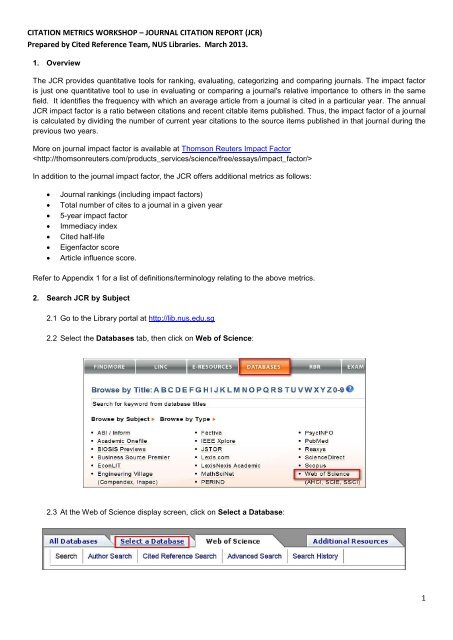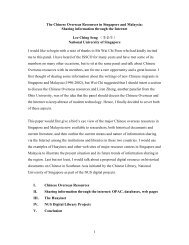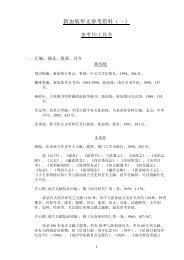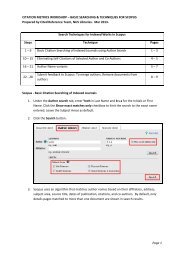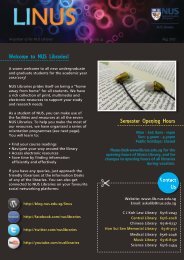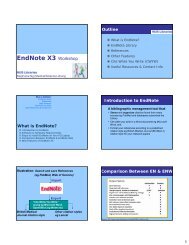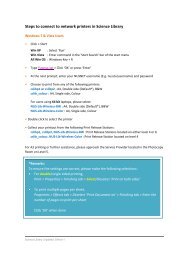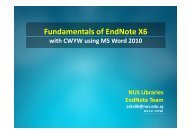JOURNAL CITATION REPORT (JCR) - NUS Libraries
JOURNAL CITATION REPORT (JCR) - NUS Libraries
JOURNAL CITATION REPORT (JCR) - NUS Libraries
Create successful ePaper yourself
Turn your PDF publications into a flip-book with our unique Google optimized e-Paper software.
<strong>CITATION</strong> METRICS WORKSHOP – <strong>JOURNAL</strong> <strong>CITATION</strong> <strong>REPORT</strong> (<strong>JCR</strong>)<br />
Prepared by Cited Reference Team, <strong>NUS</strong> <strong>Libraries</strong>. March 2013.<br />
1. Overview<br />
The <strong>JCR</strong> provides quantitative tools for ranking, evaluating, categorizing and comparing journals. The impact factor<br />
is just one quantitative tool to use in evaluating or comparing a journal's relative importance to others in the same<br />
field. It identifies the frequency with which an average article from a journal is cited in a particular year. The annual<br />
<strong>JCR</strong> impact factor is a ratio between citations and recent citable items published. Thus, the impact factor of a journal<br />
is calculated by dividing the number of current year citations to the source items published in that journal during the<br />
previous two years.<br />
More on journal impact factor is available at Thomson Reuters Impact Factor<br />
<br />
In addition to the journal impact factor, the <strong>JCR</strong> offers additional metrics as follows:<br />
<br />
<br />
<br />
<br />
<br />
<br />
<br />
Journal rankings (including impact factors)<br />
Total number of cites to a journal in a given year<br />
5-year impact factor<br />
Immediacy index<br />
Cited half-life<br />
Eigenfactor score<br />
Article influence score.<br />
Refer to Appendix 1 for a list of definitions/terminology relating to the above metrics.<br />
2. Search <strong>JCR</strong> by Subject<br />
2.1 Go to the Library portal at http://lib.nus.edu.sg<br />
2.2 Select the Databases tab, then click on Web of Science:<br />
2.3 At the Web of Science display screen, click on Select a Database:<br />
1
2.4 From the list of databases displayed, select Journal Citation Reports<br />
:<br />
2.5 At the Journal Citation Reports screen, select a <strong>JCR</strong> Edition (Science or Social Sciences) and year.<br />
Select also one of the following search options from the drop-down menu:<br />
View a group of journals by Subject category or Publisher, or country/territory<br />
Search for a specific journal (by full/abbreviated journal title, title word or ISSN)<br />
View all journals<br />
In the above example, we have chosen <strong>JCR</strong> Social Science Edition for the year 2011 to run a <strong>JCR</strong> report for<br />
a group of journals by Subject Category.<br />
2.6 At the Subject Category Selection page shown below, select to group journals by the Subject Category<br />
Geography and finally choose to display Journal Data sorted by impact factor.<br />
2
2.7 After making the above selections, <strong>JCR</strong> produces a list of journals in Geography published in 2011 and<br />
ranked by impact factor. You can re-sort all the journals in the list by using the dropdown menu at the top of<br />
the screen. To save specific journal titles into a list, click the checkbox next to each journal title desired and<br />
then click the Update Marked List at the top of the screen:<br />
2.8 Click the Marked List button to produce a final list of only those titles you wish to keep:<br />
3
2.9 The new screen will give you the option to either save the selected journal title data to a file that can be e-<br />
mailed as an attachment, or you can reformat the list for printing:<br />
3. Search <strong>JCR</strong> by Journal Title<br />
3.1 Go to Journal Citation Reports database.<br />
3.2 Choose the Science or Social Sciences Edition and the year 2011. Select an option to search for a specific<br />
journal title:<br />
3.3 To search for a specific journal, you may search by Full or Abbreviated journal title, title word, or ISSN. We will<br />
search for the journal Urban Geography:<br />
4
3.4 Click on the hyperlinked journal title to see more information on the journal including Impact Factor,<br />
Immediacy Index, Cited Half-Life, Cited Journal Graph, etc.<br />
3.5 Details for the journal Urban Geography will be displayed at the subsequent screen as shown below:<br />
5
Suggested Readings<br />
Althouse, B. M., West, J. D., Bergstrom, C. T., & Bergstrom, T. (2009). Differences in Impact Factor Across Fields and<br />
Over Time. Journal of the American Society for Information Science and Technology, 60(1), 27-34. doi:<br />
10.1002/asi.20936<br />
Archambault, E., & Larivière, V. (2009). History of the journal impact factor: Contingencies and consequences.<br />
Scientometrics, 79(3), 635-649.<br />
Bensman, S. J. (2008). Distributional differences of the Impact Factor in the sciences versus the social sciences: An<br />
analysis of the probabilistic structure of the 2005 Journal Citation Reports. Journal of the American Society for<br />
Information Science and Technology, 59(9), 1366-1382. doi: 10.1002/asi.20810<br />
Dorta-González, P., & Dorta-González, M. I. (2012). Comparing journals from different fields of science and social<br />
science through a <strong>JCR</strong> subject categories normalized impact factor. Scientometrics, 1-28.<br />
Franceschet, M. (2010). Journal influence factors. Journal of Informetrics, 4(3), 239-248. doi:<br />
10.1016/j.joi.2009.12.002<br />
Leydesdorff, L., & Rafols, I. (2011). Indicators of the interdisciplinarity of journals: Diversity, centrality, and citations.<br />
Journal of Informetrics, 5(1), 87-100. doi: 10.1016/j.joi.2010.09.002<br />
Pontille, D., & Torny, D. (2010). The controversial policies of journal ratings: evaluating social sciences and humanities.<br />
Research Evaluation, 19(5), 347-360. doi: 10.3152/095820210x12809191250889<br />
6
Appendix 1 Definitions & Terminologies (Adapted from the <strong>JCR</strong> Quick Reference Guide)<br />
Cited Half-Life: Benchmarks the age of cited articles by showing the number of years back from the current year that<br />
account for 50% of the total number of citations to a journal in the current year.<br />
Immedicacy Index: Measures how frequently the average article from a journal is cited within the same year as<br />
publication. This number is useful for evaluating journals that publish cutting-edge research.<br />
Journal Impact Factor: Identifies the frequency with which an average article from a journal is cited in a particular<br />
year. You can use this number to evaluate or compare a journal's relative importance to others in the same field or<br />
see how frequently articles are cited.<br />
Five-Year Impact Factor: Average number of times articles from the journal published in the last five years has been<br />
cited in the <strong>JCR</strong> year. This metric can be used to better gauge the impact of journals in fields where the influence of<br />
published research evolves over a longer period of time.<br />
Eigenfactor Score: The Eigenfactor Score is measured using the current <strong>JCR</strong> year citations to citable items from the<br />
five previous years. While the Impact Factor weighs each citation to a journal equally, the Eigenfactor Score assigns<br />
a greater weight to those citations coming from influential journals, allowing these journals to exert greater influence in<br />
the determination of the rank of any journal which they reference. The Eigenfactor Score does not count journal selfcitations.<br />
The sum of Eigenfactor Scores for all journals is 100; each journal's Eigenfactor Score is a percentage of<br />
this total.<br />
Article Influence Score: The Article Influence Score measures the relative importance of the journal on a per-article<br />
basis. It is the journal's Eigenfactor Score divided by the fraction of articles published by the journal. That fraction is<br />
normalized so that the sum total of articles from all journals is 1.<br />
The mean Article Influence Score is 1.00. A score greater than 1.00 indicates that articles in that journal have aboveaverage<br />
influence. A score less than 1.00 indicates that articles in the journal have a below-average influence.<br />
Journal Self-Cites: Refers to a paper in a journal citing another paper from the SAME journal. Journal Citation<br />
Reports shows what percentage of a journal's total citation count is a result of journal self-citation, and provides an<br />
adjusted Impact Factor that excludes journal self-cites.<br />
7


